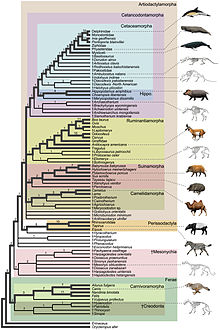- Whippomorpha
-
Whippomorpha 
Scientific classification Kingdom: Animalia Phylum: Chordata Subphylum: Vertebrata Class: Mammalia Order: Artiodactyla Suborder: Cetruminantia Infraorder: Whippomorpha Families †Anthracotheriidae
Hippopotamidae
†Dichobunidae
†Helohyidae
†Cebochoeridae
†Raoellidae
†Pakicetidae
†Ambulocetidae
†Remingtonocetidae
†Protocetidae
†Basilosauridae
†Llanocetidae
†Mammalodontidae
†Kekenodontidae
†Janjucetidae
†Aetiocetidae
†Cetotheriidae
Balaenidae
Balaenopteridae
Eschrichtiidae
Neobalaenidae
†Simocetidae
†Agorophiidae
Physeteridae
Kogiidae
†Eurhinodelphinidae
†Eoplatanistidae
†Dalpiazinidae
†Waipatiidae
†Squalodelphinidae
Platanistidae
Ziphiidae
Lipotidae
Pontoporiidae
Iniidae
†Squalodontidae
†Kentriodontidae
Delphinidae
†Odobenocetopsidae
Monodontidae
PhocoenidaeWhippomorpha[1] is a proposed clade containing the Cetacea (whales, dolphins, etc.) and their closest living relatives, the hippopotamuses defined by Waddell et al. (1999). It's defined as a node-based taxon, including all species that are descendants of the most recent common ancestor of Hippopotamus amphibius and Tursiops truncatus.[2] This would be a sub-grouping of the Cetartiodactyla (which also includes pigs and ruminants), but it is not clear how recently the whales and hippos share a common ancestor, though the genetic evidence is strong that the cetaceans arose from within the Artiodactyla, thus making the even-toed ungulate grouping a paraphyletic one.[3]
Whippomorpha is a mixture of English (wh[ale] + hippo[potamus]) and Greek (morphe = form). Attempts have been made to rename the clade Cetancodonta but Whippomorpha maintains precedent.[4][5]
Cetartiodactyla Artiofabula Cetruminantia Whippomorpha References
- ^ Waddell, P.J., Okada, N. & Hasegawa, M. (1999) Towards Resolving the Interordinal Relationships of Placental Mammals. Systematic Biology 48, pp. 1-5. [1]
- ^ Ibid.
- ^ A higher-level MRP supertree of placental mammals
- ^ Robert J Asher and Kristofer M Helgen BMC Evolutionary Biology 2010, 10:102 doi:10.1186/1471-2148-10-102 [2]
- ^ . PMC 2740860. http://www.pubmedcentral.nih.gov/articlerender.fcgi?tool=pmcentrez&artid=2740860.

This article about a mammal is a stub. You can help Wikipedia by expanding it.

